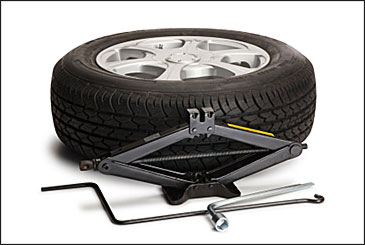Not being able to fix a flat on your own can make you feel stranded and powerless. Changing a flat tire is not terribly difficult, though, and just about anyone can do it. Read on to learn how to change a flat tire step by step.
Before you can begin changing a flat tire, you should take steps to prevent your vehicle from rolling. If at all possible, the car should be on level ground. Put the car in park and make sure the parking brake is applied as well. Block the wheel diagonal to the one you will be removing. You can use a wheel chock, a wooden block, a brick or a large rock.
Now grab the spare, your lug wrench and your jack. The location of your spare tire should be obvious, but sometimes the jack and lug nut wrench are stored separately. There may be a compartment inside the trunk where the tools you need to change your tire are stored. Look along the sides of your trunk if you do not see them at first.

Everything You Need to Fix a Flat Tire
If you have a wheel cover to contend with, having a flat screwdriver available for prying the cover off is handy. If you do not want to scratch your wheel rims when removing the wheel cap and you have some tape available as well, wrap the screwdriver with tape. Just insert the point of the screwdriver where the edge of the cover meets the wheel, as if you are prying the lid off of a can of paint. Apply a little pressure until the cap pops off. You might need to do this in more than spot to get the wheel cover off.
Lug nuts can be extremely tight so to get maximum leverage, loosen the lug nuts before you jack up the car. Turn the wrench counterclockwise, i.e. to the left, in order to loosen. For stubborn lug nuts, you may need to apply the full force of your body weight in order to loosen them. Do not remove them completely, but loosen them to the point where they can be removed by hand once the wheel is off the ground.
Once the lug nuts are sufficiently loose, you are ready to jack up your car. Consult your manual for the manufacturer recommended jack points and place your jack where instructed. Jacking points are usually in front of the back wheels and behind the front wheels. Most car makers provide a scissor jack because it is compact, light, easy to store, and easy to use. The car is raised and lowered by turning the lever. Your jack may not have a handle attached, in which case you insert the rod that comes with it or the lug wrench over the knob and start cranking. Carefully jack up the car high enough to put the new tire on.
Now you can remove the lug nuts completely by hand. Make sure you keep track of them and that they do not roll away. Grab the flat tire and pull it straight toward you. Set it aside and out of the way.
Lift the spare tire up and onto the lug bolts. The air valve should be facing out. Replace the lug nuts and hand tighten them as tight as you can. You will use the lug wrench to tighten them as much as possible once the car is on the ground.
Carefully lower the vehicle then finish tightening the lug nuts with your lug wrench. The nuts should be tightened incrementally in a diagonal pattern. Replace the wheel cover after the lug nuts are fully tightened and you are good to go.
Now that you know how to change a flat tire, it would be a good time to check the pressure on your spare and make sure you have all the tools you will need in order to change a flat. If changing a flat tire sounds as though it is not all that difficult, that is because it really is fairly easy. To be sure, you do not need to learn everything there is to know about auto repair in order to drive safely or enjoy driving. Because flat tires are an all too frequent occurrence, however, knowing how to change a flat tire is in your best interests and can save you time and money.